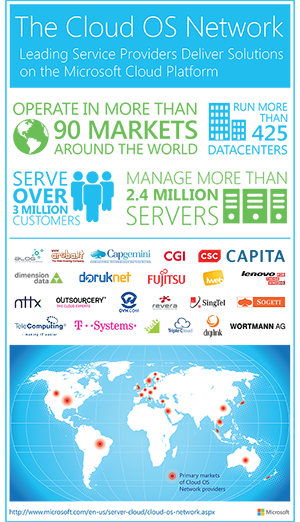REDMOND, Wash. — Dec. 12, 2013 — On Thursday, Microsoft Corp. introduced the Cloud OS Network, a worldwide consortium of more than 25 cloud service providers delivering services built on the Microsoft Cloud Platform: Windows Server with Hyper-V, System Center and the Windows Azure Pack. These organizations support Microsoft’s Cloud OS vision of a consistent platform that spans customer datacenters, Windows Azure and service provider clouds. Service providers in the Cloud OS Network offer Microsoft-validated, cloud-based infrastructure and application solutions designed to meet customer needs.
“This network of leading service providers will help our customers create datacenters without boundaries for apps, data and device management,” said Takeshi Numoto, Microsoft corporate vice president of Cloud & Enterprise Marketing. “That translates into greater diversity of solutions, more flexibility and lower operational costs for customers, allowing them to focus on their core business rather than managing datacenters.” More comments from Numoto can be found on the Official Microsoft Blog.
Hybrid benefits for customers
Every organization has different needs and different IT requirements for addressing those needs. With the Cloud OS Network, customers now have even more choice in deploying hybrid solutions on the Microsoft Cloud Platform — either in their datacenter, in Windows Azure or, now, through a network of service providers. Customers also benefit from uniquely tailored, fully managed services within their local market, as well as a high degree of technical consistency across environments, which prevents vendor lock-in and enables flexibility. As a result, customers can focus on increasing efficiencies, improving employee productivity and lowering operational costs. Customers interested in the Cloud OS Network and the services offered by these partners can find additional information here.
Cloud service provider opportunity
As cloud adoption accelerates, service providers are focused on delivering value-added services to meet customer demand for hybrid cloud solutions. By joining Microsoft in the Cloud OS Network, leading cloud service providers can quickly and cost-effectively develop new services, attract new customers and increase revenues. With the Microsoft Cloud Platform, service providers have access to the capabilities of and best practices from Windows Azure.
“CSC continues to expand our strategic partnership with Microsoft to increase value to our clients and bring next-gen solutions to market,” said Marc Silvester, vice president of Offerings Management at CSC. “CSC and Microsoft continue to partner on offerings that leverage the tremendous growth in apps, devices and data that are driven by the rise of cloud computing. As these technologies play an ever-increasing role in business, CSC and Microsoft are working together to drive more efficiency and value through Microsoft’s Cloud OS vision. CSC is proud to be part of Microsoft’s Cloud OS Network.”
Watch what service providers have to say about Microsoft’s new Cloud OS Network here.
Worldwide reach
Organizations within the Cloud OS Network cover more than 90 active markets around the world, serve more than 3 million customers every day and operate over 2.4 million servers in more than 425 datacenters.
Partners in the Cloud OS Network include, among others, Alog, Aruba S.p.A., Capgemini, Capita IT Services, CGI, CSC, Dimension Data, DorukNet, Fujitsu Finland Oy., Fujitsu Ltd., iWeb, Lenovo, NTTX, Outsourcery, OVH.com, Revera, SingTel, Sogeti, TeleComputing, Tieto, Triple C Cloud Computing, T-Systems, VTC Digilink and Wortmann AG.
More details on today’s announcements can be found at the Microsoft News Center.
Founded in 1975, Microsoft (Nasdaq “MSFT”) is the worldwide leader in software, services and solutions that help people and businesses realize their full potential.
Note to editors: For more information, news and perspectives from Microsoft, please visit the Microsoft News Center at http://www.microsoft.com/news. Web links, telephone numbers and titles were correct at time of publication, but may have changed. For additional assistance, journalists and analysts may contact Microsoft’s Rapid Response Team or other appropriate contacts listed at http://www.microsoft.com/news/contactpr.mspx.





